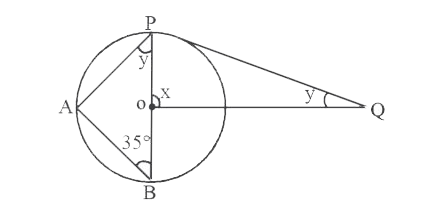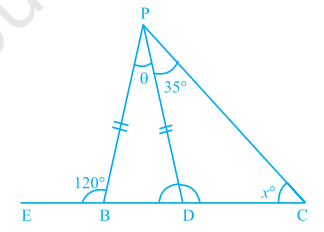In an electrochemical reaction of lead, at standard temperatureif E∘_((Pb)2+/(Pb))=mVolt andE∘_((Pb)4+/(Pb))=n Volt,then the value of E∘_(Pb2+/Pb4+)=n is given by m-xn.The value of x is (Nearest integer)
To solve the problem, we need to find the value of x in the equation:
E@(Pb2+//Pb4+)=n=m−xn
1. Identify the Reactions:
- The first reaction is:
Pb2++2e−→Pb(E@=m Volts)
- The second reaction is:
Pb4++4e−→Pb(E@=n Volts)
2. Determine the Overall Reaction:
- We want to find the potential for the reaction:
Pb2+→Pb4++2e−
- This can be derived from the two reactions above.
3. Use the Nernst Equation:
- The Gibbs free energy change (ΔG) is related to the standard electrode potential (E@) by the equation:
ΔG=−nFE@
- For the overall reaction, we can write:
ΔGtotal=ΔG1−ΔG2
4. Express Gibbs Free Energy for Each Reaction:
- For the first reaction:
ΔG1=−2FE@(Pb2+//Pb)=−2Fm
- For the second reaction:
ΔG2=−4FE@(Pb4+//Pb)=−4Fn
5. Combine the Gibbs Free Energy Changes:
- Thus, the overall Gibbs free energy change for the reaction Pb2+→Pb4++2e− becomes:
ΔGtotal=−2Fm+4Fn
6. Relate to the Overall Standard Potential:
- Therefore, we can express the overall standard potential as:
−nFE@(Pb2+//Pb4+)=−2Fm+4Fn
- Dividing through by −nF gives:
E@(Pb2+//Pb4+)=2m−4n2
7. Simplify the Expression:
- Simplifying the expression yields:
E@(Pb2+//Pb4+)=m−2n
8. Identify the Value of x:
- From the equation E@(Pb2+//Pb4+)=n=m−xn, we can see that:
x=2
Final Answer:
The value of x is 2.
- The first reaction is:
Pb2++2e−→Pb(E@=m Volts)
- The second reaction is:
Pb4++4e−→Pb(E@=n Volts)
- We want to find the potential for the reaction:
Pb2+→Pb4++2e−
- This can be derived from the two reactions above.
- The Gibbs free energy change (ΔG) is related to the standard electrode potential (E@) by the equation:
ΔG=−nFE@
- For the overall reaction, we can write:
ΔGtotal=ΔG1−ΔG2
- For the first reaction:
ΔG1=−2FE@(Pb2+//Pb)=−2Fm
- For the second reaction:
ΔG2=−4FE@(Pb4+//Pb)=−4Fn
- Thus, the overall Gibbs free energy change for the reaction Pb2+→Pb4++2e− becomes:
ΔGtotal=−2Fm+4Fn
- Therefore, we can express the overall standard potential as:
−nFE@(Pb2+//Pb4+)=−2Fm+4Fn
- Dividing through by −nF gives:
E@(Pb2+//Pb4+)=2m−4n2
- Simplifying the expression yields:
E@(Pb2+//Pb4+)=m−2n
- From the equation E@(Pb2+//Pb4+)=n=m−xn, we can see that:
x=2
The value of x is 2.
Topper's Solved these Questions
Similar Questions
Knowledge Check
- Question 1 - Select One
In the given fig. PQ is tangent and PB is diameter. Find the value of x and y.
 Ax=35∘ & y=55∘Bx=25∘ & y=55∘Cx=35∘ & y=95∘DNone
Ax=35∘ & y=55∘Bx=25∘ & y=55∘Cx=35∘ & y=95∘DNone - Question 2 - Select One
The size of the species, Pb,Pb2+,Pb4+ decreases as -
APb4+>Pb2+>PbBPb>Pb2+>Pb4+CPb>Pb4+>Pb2+DPb4+>Pb>Pb2+ - Question 3 - Select One
The size of the species, Pb,Pb2+,Pb4+ decreases as -
APb4+>Pb2+>PbBPb>Pb2+>Pb4+CPb>Pb4+>Pb2+DPb4+>Pb>Pb2+
Calculate the oxidation number of lead in Pb3O4 ?
View SolutionPredict whether Ag+ can oxidize Pb to Pb2+ under standard state conditions.
E∘Ag=0.799VandE∘Pb=−0.126V.View SolutionPredict reaction of 1N sulphuric acid with following metals : (i) copper (ii) lead (iii) iron Given, E0Cu2+∣Cu= 0.34volt , E0Pb2+∣Pb = -0.13 volt, E0Fe2+∣Fe = -0.44 volt
View SolutionCalculate the e.m.f. of the cell,
Zn(s)/Zn2+(0.1M)∣∣Pb2+(0.02M)/Pb(s)
E∘Zn2+/Zn=−0.76 V andE∘Pb2+/Pb=−0.13 VView SolutionGiven: E0Sn2+/Sn=−0.14V , E0Pb2+/Pb=−0.13V. Determine [(Sn2+)/(Pb2+)] at equilibrium. For cell reaction Sn∣∣Sn2+∣∣∣∣Pb2+∣∣Pb , Take (2.303RT)/F=0.06V
View Solution


